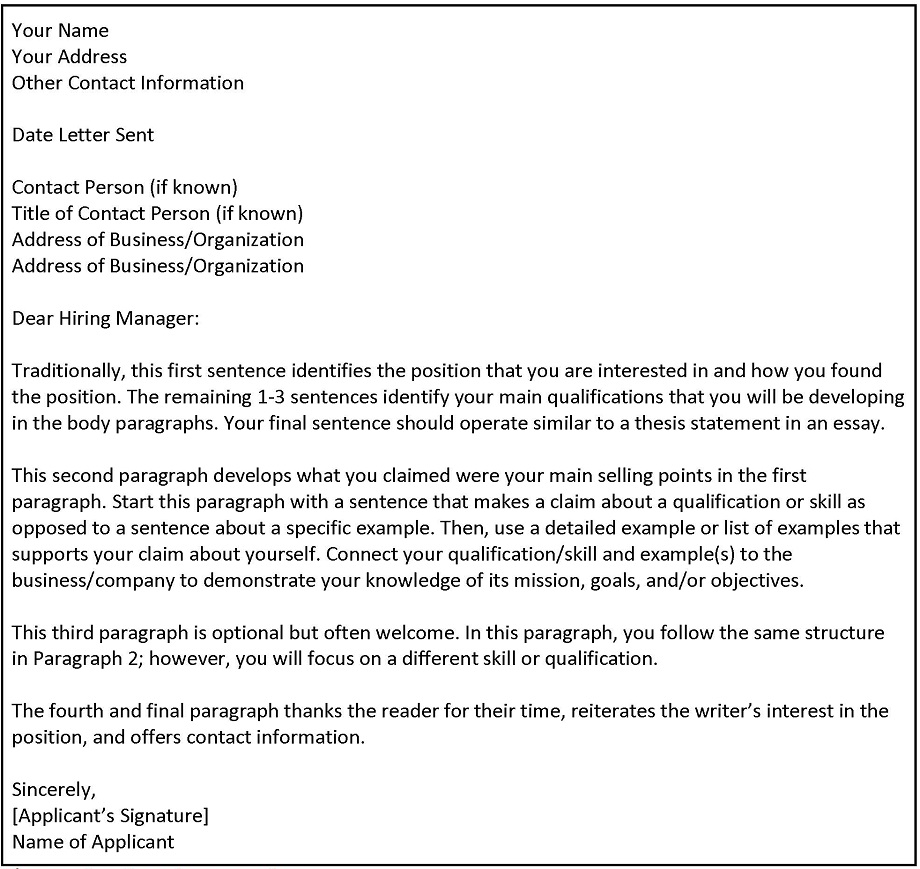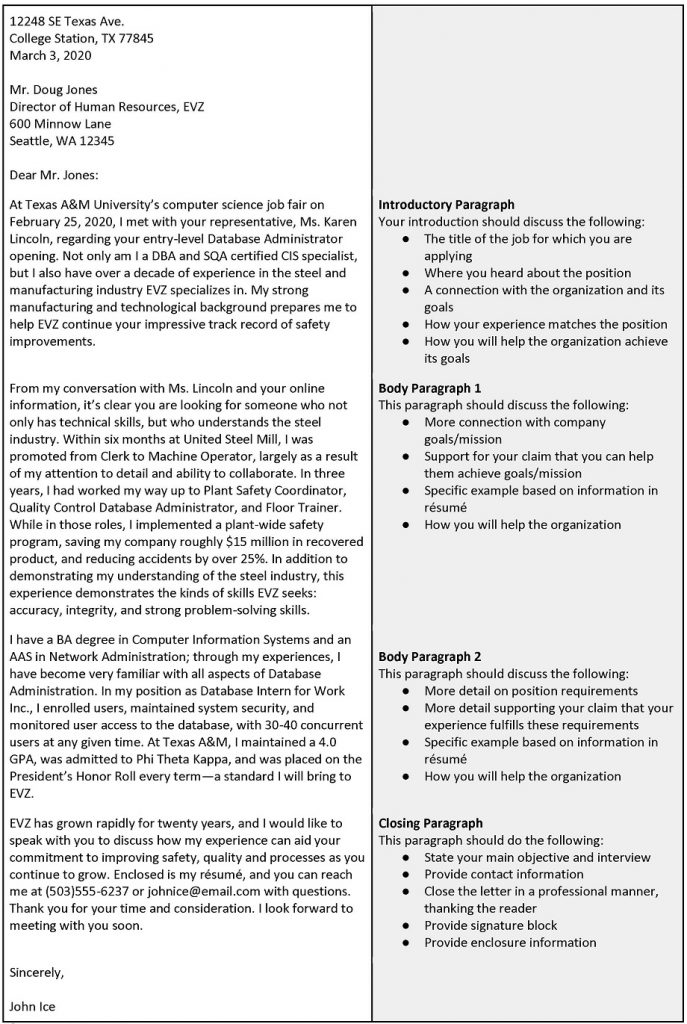16 – Applications
Cover Letters
Megan Savage; James Francis, Jr.; Matt McKinney; and Nicole Hagstrom-Schmidt
In the era of social media, the idea of writing a cover letter to introduce your résumé may seem outdated. However, the cover letter still serves a few critical functions. If the résumé is characterized by breadth (giving a broad overview of your qualifications), the cover letter is characterized by depth (choosing a few most significant qualifications to cover in detail). Written in paragraphs rather than bullet points, the cover letter is the first writing sample your employer will see from you. In paragraphed prose, it is easier to market your unique qualifications and show how you will fit in with the culture of the company. An effective cover letter will create a picture of you as a potential employee and inspire a potential employer to learn more about you.
Your cover letter is essentially an argument for why you should be granted an interview. Keep the following tips in mind as you write your cover letter:
- Support the claim that you are qualified for the position with evidence. Demonstrate your authority by speaking in detail about your qualifications, and show the reader that you have the skills and abilities necessary to do the job at hand. The more detail you offer and the more precise your language is, the more the reader will be able to picture you doing the job. See the sample cover letter in Figure 16.5 below for examples of “showing.”
- Use research and rhetoric to effectively appeal to the company or organization’s expectations. Your audience analysis research will help you connect with the company and choose the appropriate tone, level of formality, and level of technicality.
- Format your letter according to common professional conventions. For the format for professional letters, see Chapter 15: Correspondence.
Outline
Cover letters follow the same general outline for their content. Cover letters typically contain a salutation, an opening paragraph that names the position and highlights your major qualifications, one or two body paragraphs elaborating on your major qualifications, a short closing paragraph thanking the reader, and a signature. Details on each component of the outline are provided below. See Figure 16.5, a cover letter template, and Figure 16.6 for an example of how these components come together in a cover letter.
- Salutation. Make your best attempt to find a specific name (or at least the job title) of the person to whom you should address this letter. If you cannot find the name, you may address the letter “Dear Hiring Manager.” Do not use “Dear Sir or Madam” or “To Whom it May Concern,” as it conveys uncertainty on whom you’re writing to and may not reflect the gender of your audience.
- Opening Paragraph. State why you are writing, specifically naming the position to which you are applying. Indicate how you learned about the position (networking if you can). In one sentence, use your audience analysis research to establish a connection with the company. Finally, in one sentence, summarize your strongest qualification(s) for the job.
Note: If you are applying for a position that isn’t local (e.g., the position is in Atlanta and you live in Houston), include a sentence here indicating that you are already in the process of relocating. If you already have an address in that area, use it in your cover letter and résumé. This sentence tells the employer that you are as serious about this job as local applicants, rather than just applying on a whim. It also gives them a clear idea of when you will be available to work.
- Body Paragraph(s). Build each paragraph around a key qualification or professional strength that relates to the job for which you are applying. These qualifications or strengths should be the ones you mentioned in your opening paragraph. Begin each paragraph with a claim about this qualification/strength, and then provide a developed illustration of a time in your work or academic history when you used/excelled at this skill or used it to benefit others. For example, if the job requires excellent customer service skills, you might discuss a time in which you defused a conflict or increased your company’s profits. It can be effective to conclude your middle paragraphs with sentences that express how these past experiences prepare you for the potential job.
- Closing Paragraph. Thank the reader for their time and consideration. Gesture towards an interview. You may explicitly request an interview, or you may wish to include a phrase like “I look forward to discussing my qualifications with you in person soon.” If there is any information the reader should know about getting in touch with you, include it. Provide your phone number and email address here if they do not appear elsewhere in the cover letter. You may refer the reader to your enclosed résumé.
- Signature. As with most letters, you should conclude your letter with a professional “farewell” such as “Sincerely” or “Regards.” Below the farewell, add the name that you use professionally. If you are able, insert your own handwritten signature. This can be done as a photograph, a scan, a copy/pasted signature from another PDF file, or a drawing. Your typed name should still go below your handwritten signature if you choose to include it.
Sample Cover Letters
Figure 16.5 below is a sample cover letter.[1]

Figure 16.6 below shows the main parts of a cover letter. [2]

This text was derived from
Savage, Megan, “Cover Letters,” licensed under a Creative Commons Attribution 4.0 International License in: Gross, Allison, Annemarie Hamlin, Billy Merck, Chris Rubio, Jodi Naas, Megan Savage, and Michele DeSilva. Technical Writing. Open Oregon Educational Materials, n.d. https://openoregon.pressbooks.pub/technicalwriting/. Licensed under a Creative Commons Attribution-NonCommercial-ShareAlike 4.0 International License.
- Nicole Hagstrom-Schmidt, “Cover Letter Template,” 2021. This image is licensed under a Creative Commons Attribution-NonCommercial-ShareAlike 4.0 International License. ↵
- This image was derived from Megan Savage, “Cover Letters,” licensed under a Creative Commons Attribution 4.0 International License in Allison Gross, Annemarie Hamlin, Billy Merck, Chris Rubio, Jodi Naas, Megan Savage, and Michele DeSilva, Technical Writing, (Open Oregon Educational Materials, n.d.), https://openoregon.pressbooks.pub/technicalwriting/. Licensed under a Creative Commons Attribution-NonCommercial-ShareAlike 4.0 International License. ↵
